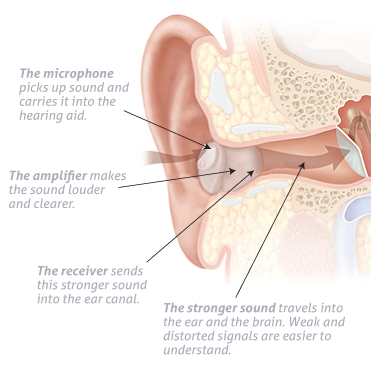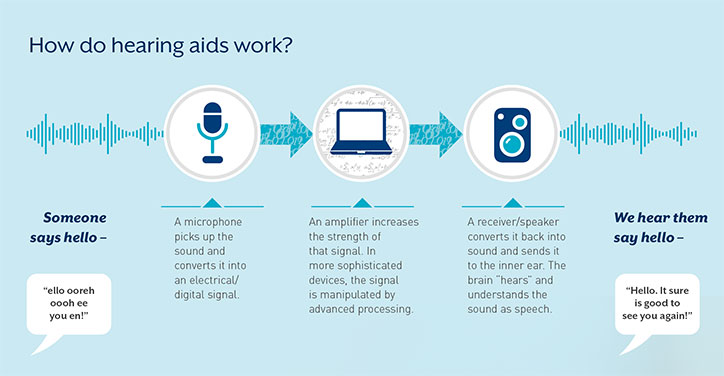How do hearing aids work?
A hearing aid is basically an amplification system. All hearing aids have the same major components to allow sound to be gathered by the device, amplified and then processed into a signal that is useful for your ear. Nowadays, hearing aids are digital and have an extra component compared to the analogue hearing aids that were mainstream a quarter of a century ago. Let’s have a closer look at the main elements of today’s hearing aid.

- The microphone – like any other microphone, will pick up incoming sound and convert it into an electrical signal.
- The processing chip – sounds from the microphone are analysed and changed according to the processing chip’s protocol. Every hearing aid manufacturer will have a different processing chip and use the available technology in a different way. Once sounds have been processed they are sent to the amplifier.
- The amplifier – is used to make sounds louder or intensify the signal from the microphone and processing chip. In a hearing aid, the amplifier can also change the sound, as it increases the volume. Depending on how it’s set up, it might increase the intensity of high pitch sounds.
- The receiver – now that the sound has been amplified to suit the wearer of the hearing aid, the electrical signal needs to be changed back into an acoustic signal. That is, a sound that can be heard by the human ear and interpreted in the brain.
- A power source or battery – up until recently, disposable batteries where the only option to power hearing aids. However rechargeable batteries are now available and becoming very popular.

So with these five components you can get a huge variety of hearing aid capabilities.
How the hearing aid uses different arrays of microphones, the chip processes sound, and what speech protocols are used in the amplification system will change the listening experience. Many hearing aids now have the ability to connect wirelessly to smart devices. Each person will have a ‘prescription’ devised for their particular hearing needs and a hearing aid will be selected and adjusted to meet these needs.
You may hear your Audiologist or Audiometrist talk about feedback cancellation, directional microphones, automatic programs, bandwidth and tinnitus support. It’s important to know what your hearing aid can do and if the features will help your particular hearing loss.
Need Help With Hearing Aids?


